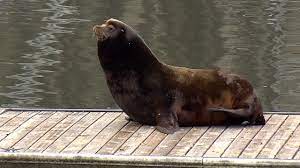PORTLAND, Ore. ( KOIN ) — The Columbia River’s first federally approved sea lion killings of 2024 will likely begin next week, NOAA Fisheries told KOIN 6 News. The sea lion “removals” or “cullings” are carried out by state and tribal officials each year to protect the threatened and endangered salmon that inhabit the river and its tributaries.
In mid-March, Portlanders documented dozens of male sea lions taking residence on the docks of Hayden Island. These sea lions are moving upriver to feast on spawning smelt and migrating salmon, wildlife officials said. Many will head back out to sea in May and June. However, a growing number of sea lions have been documented hunting in the river each year and for longer periods of time. Steller sea lions, for example, which were first spotted at the Bonneville Dam in 2003, are now known to hunt near the dam 11 months out of the year, NOAA Fisheries states on its website .
“The U.S. population of California sea lions on the west coast has grown from fewer than 75,000 to an estimated 257,000 animals over the last 30 years,” NOAA said. “The abundance of California sea lions in the Columbia River basin alone has increased from less than 500 to around 4,000 animals in the past decade.”

NOAA Fisheries expanded upon that authority in 2020 , revising the Marine Mammal Protection Act to allow local states and tribes to kill any California or Steller sea lions in zones of the Columbia River where they are known to specifically prey on at-risk salmon and steelhead.
Regional NOAA Fisheries spokesperson Michael Milstein told KOIN 6 News that 25 Steller sea lions and 22 California sea lions were legally killed in the Columbia River in 2023.
“None have been removed yet in 2024,” Milstein said. “They are just starting to ramp up efforts and probably will begin next week.”
Oregon Department of Fish and Wildlife data shows that 411 sea lions have been killed in the Bonneville Dam and Willamette Falls areas since 2008. The removal of these sea lions has saved thousands of threatened and endangered salmon in the Columbia River since the program began, according to NOAA .
“Before sea lion management, data showed that sea lions were consuming significant numbers of fish — up to 44% of the Columbia River spring Chinook run and 25% of the Willamette winter steelhead run each year,” the ODFW website states. “Since sea lion management began, these rates have been significantly reduced.”
As of August 2020, state and tribal officials estimate that approximately 290 California sea lions and 130 Steller sea lions hunt within the Columbia River Basin each year. Because these numbers represent less than 0.1% and 0.18% of the total species populations, respectively, the annual number of sea lion killings in the Columbia River is said to have no impact on the population health of either species. However, not killing the sea lions could be disastrous for the region, the ODFW states.
“The ongoing imperiled status of these culturally and economically important fish is not only costing the region millions in direct investments, but also in opportunity costs associated with lost fisheries, restricted power generation and constraints on land and water use,” the ODFW said. “If predation by sea lions at these environmental pinch points is not addressed as a tipping point, there is a high risk that these investments will fail, many efforts will be negated and additional and irreplaceable native fish runs will be extirpated at increasing rates.”



